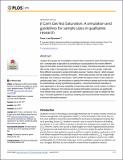Por favor, use este identificador para citar o enlazar a este item:
http://hdl.handle.net/10261/161692COMPARTIR / EXPORTAR:
 SHARE SHARE
 CORE
BASE CORE
BASE
|
|
| Visualizar otros formatos: MARC | Dublin Core | RDF | ORE | MODS | METS | DIDL | DATACITE | |

| Título: | (I Can’t Get No) Saturation: A simulation and guidelines for sample sizes in qualitative research |
Autor: | Rijnsoever, Frank J. van | Fecha de publicación: | 2017 | Editor: | Public Library of Science | Citación: | PLoS ONE 12(7): e0181689 (2017) | Resumen: | I explore the sample size in qualitative research that is required to reach theoretical saturation. I conceptualize a population as consisting of sub-populations that contain different types of information sources that hold a number of codes. Theoretical saturation is reached after all the codes in the population have been observed once in the sample. I delineate three different scenarios to sample information sources: “random chance,” which is based on probability sampling, “minimal information,” which yields at least one new code per sampling step, and “maximum information,” which yields the largest number of new codes per sampling step. Next, I use simulations to assess the minimum sample size for each scenario for systematically varying hypothetical populations. I show that theoretical saturation is more dependent on the mean probability of observing codes than on the number of codes in a population. Moreover, the minimal and maximal information scenarios are significantly more efficient than random chance, but yield fewer repetitions per code to validate the findings. I formulate guidelines for purposive sampling and recommend that researchers follow a minimum information scenario. | Versión del editor: | https://doi.org/10.1371/journal.pone.0181689 | URI: | http://hdl.handle.net/10261/161692 | DOI: | 10.1371/journal.pone.0181689 | Identificadores: | doi: 10.1371/journal.pone.0181689 e-issn: 1932-6203 |
| Aparece en las colecciones: | (INGENIO) Artículos |
Ficheros en este ítem:
| Fichero | Descripción | Tamaño | Formato | |
|---|---|---|---|---|
| icanotget.pdf | 4,12 MB | Adobe PDF |  Visualizar/Abrir |
CORE Recommender
PubMed Central
Citations
52
checked on 17-abr-2024
SCOPUSTM
Citations
136
checked on 19-abr-2024
WEB OF SCIENCETM
Citations
112
checked on 28-feb-2024
Page view(s)
401
checked on 19-abr-2024
Download(s)
341
checked on 19-abr-2024

